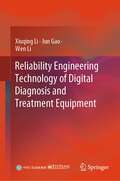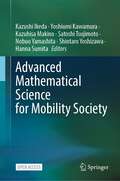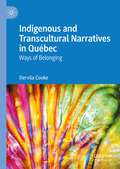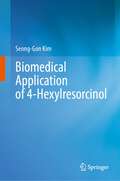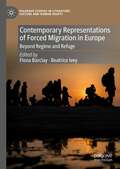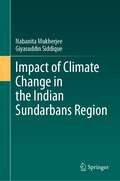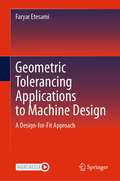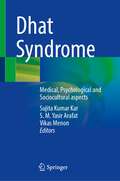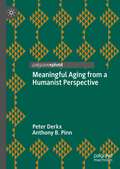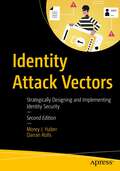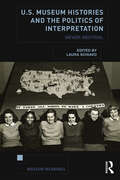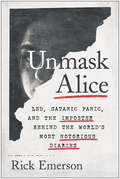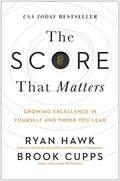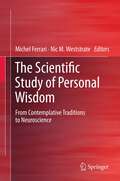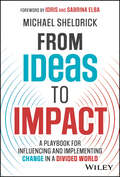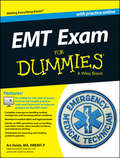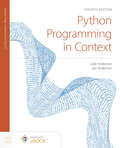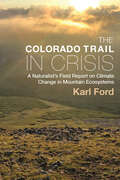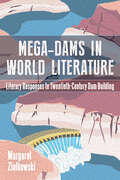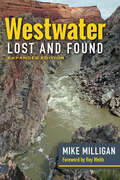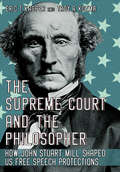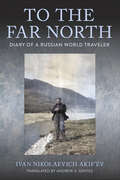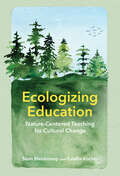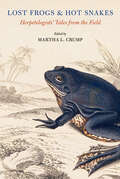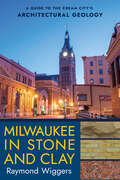- Table View
- List View
Reliability Engineering Technology of Digital Diagnosis and Treatment Equipment
by Xiuqing Li Jun Gao Wen LiThis book focuses on the reliability engineering of medical devices, especially digital diagnosis and treatment equipment in China. It details the professional technologies and application methods of reliability design analysis, fault model analysis and reliability test of digital diagnosis and treatment equipment, to meet the needs of project undertakers of digital diagnosis and treatment equipment. From the three aspects: safety analysis and EMC design protection, material selection and control, and software engineering and quality, this book provides professional and technical ideas and methods of reliability for the quality problems prone to occur in the field of medical devices, as well as method guidance for readers. Meanwhile, it runs through the whole process of design, engineering, testing, production and management of all digital diagnosis and treatment equipment research and development enterprises and even product R & D enterprises in the field of medicaldevices. It is used as reading materials for personnel of testing institutions and evaluation institutions in medical devices.
Advanced Mathematical Science for Mobility Society
by Kazushi Ikeda Yoshiumi Kawamura Kazuhisa Makino Satoshi Tsujimoto Nobuo Yamashita Shintaro Yoshizawa Hanna SumitaThis open access book presents the mathematical methods for huge data and network analysis.The automotive industry has made steady progress in technological innovations under the names of Connected Autonomous-Shared-Electric (CASE) and Mobility as a Service (MaaS). Needless to say, mathematics and informatics are important to support such innovations. As the concept of cars and movement itself is diversifying, they are indispensable for grasping the essence of the future mobility society and building the foundation for the next generation. Based on this idea, Research unit named "Advanced Mathematical Science for Mobility Society" was established at Kyoto University as a base for envisioning a future mobility society in collaboration with researchers led by Toyota Motor Corporation and Kyoto University.This book contains three main contents.1. Mathematical models of flow2. Mathematical methodsfor huge data and network analysis3. Algorithm for mobility societyThe first one discusses mathematical models of pedestrian and traffic flow, as they are important for preventing accidents and achieving efficient transportation. The authors mainly focus on global dynamics caused by the interaction of particles. The authors discuss many-body particle systems in terms of geometry and box-ball systems. The second one consists of four chapters and deals with mathematical technologies for handling huge data related to mobility from the viewpoints of machine learning, numerical analysis, and statistical physics, which also includes blockchain techniques. Finally, the authors discuss algorithmic issues on mobility society. By making use of car-sharing service as an example of mobility systems, the authors consider how to construct and analyze algorithms for mobility system from viewpoints of control, optimization, and AI.
Indigenous and Transcultural Narratives in Québec: Ways of Belonging
by Dervila CookeThis book focuses on modes of cultural belonging in Québec. It looks at recent literary memoir, autobiographical fiction, and documentary testimony. Through four in-depth case studies of cultural creators, one Indigenous and three non-Indigenous, Dervila Cooke discusses multicultural and ethnically diverse society in Québec, examining current tensions, challenges, and opportunities. Works studied range from Abla Farhoud’s first novel in 1998 to Anita Aloisio’s 2022 documentary film Calliari, QC. Topics include the desire for freedom to self-ascribe and enact cultural identity, self-reinvention through fiction, expressions of Indigeneity in Naomi Fontaine, the term “Québécois”, especially after Bill 21, and the thorny question of integration of immigrants, discussed in relation to Akos Verboczy’s Rhapsodie québécoise. As with the companion volume on France, societal factors are discussed, here relating to the cultural renaissance of Indigenous writing, Farhoud’s Libano-Québécois context, and language laws in Québec, including the foundational Bill 101 and the more recent Bill 96.
Biomedical Application of 4-Hexylresorcinol
by Seong-Gon Kim“Biomedical Application of 4-Hexylresorcinol” is a comprehensive review of the latest research findings on the biomedical effects of 4-hexylresorcinol (4HR), a compound widely used as an antiseptic and food additive to prevent melanosis. Over the past two decades, the author has conducted extensive studies on 4HR, uncovering additional properties and applications that extend far beyond its traditional uses. This book aims to provide a thorough understanding of 4HR’s numerous mechanisms and potential applications, with a focus on its anti-cancer, anti-inflammatory, and antioxidant effects. The book, “Biomedical Application of 4-Hexylresorcinol,” is poised to fill this critical knowledge gap. It will captivate professionals in the realms of biomedical research, medicine, and pharmacology, as well as students pursuing these disciplines. What truly sets our book apart is its unique concentration on 4HR and the wide-ranging applications in biomedical research and clinical practice. As interest in alternative therapeutic approaches continues to grow, along with the increasing acknowledgment of the value of natural compounds, this book is perfectly positioned to become an indispensable resource for researchers, clinicians, and aspiring professionals alike.
Contemporary Representations of Forced Migration in Europe: Beyond Regime and Refuge (Palgrave Studies in Literature, Culture and Human Rights)
by Fiona Barclay Beatrice IveyThis book engages with current debates around refugeedom by examining cultural production that represents and interrogates the construction of refugees and the refugee experience on the borders of contemporary Europe. The refugee subject is produced by discursive regimes and border practices inherited from colonial projects that construct the diametrically opposed concepts of citizen and refugee, and their attendant administrative sub-categories. In the early twenty-first century these categories have been strengthened by the politicisation of forced migration and the hardening of ‘Fortress Europe’. While the predominant response to the increasing numbers of refugees seeking asylum in Europe has been to harden the borders (regime), on the one hand, or to stress the common humanity of those displaced (refuge), on the other, this volume argues that both approaches result in refugees becoming objectified, othered, and abstracted as vectors ofexile. It explores what recent cultural production can achieve in engaging with and representing issues of dispossession, detention and resettlement, and probes the limits of artistic potential to mediate the refugee experience. It examines transnational approaches to cultural production that both occupy and exceed the borders of Europe, with a focus on borderscapes, spaces of detention, and (neo-)colonialism. Bringing together original contributions from an international range of scholars, it analyses contemporary textual and visual representations of forced migration to argue that other forms of solidarity and hospitality towards refugees in Europe and beyond must be possible.
Impact of Climate Change in the Indian Sundarbans Region
by Nabanita Mukherjee Giyasuddin SiddiqueThis book studies climate change vulnerability in the Southern Part of the Indian Sundarbans Region, West Bengal, following the IPCC framework which highlights three prime components of vulnerability - exposure, sensitivity and adaptive capacity. This framework is considered as one of the best methods of vulnerability assessment as it uses direct household perception through collection of primary data, and recognizes a household’s proficiency in maintaining sustainable means of livelihood to deal with climatic changes. This is especially important in gauging the knowledge and perception of local indigenous people on climate change, and determining what measures can be taken to foster informed decision making for improved climate change adaptation and management. The specific impact of climate change on women, their lives and livelihood are also given due attention, as there is little written about gendered vulnerability to climate change in the region. The final chapter elaborates the limits, barriers to adaptation of climate change and also extends site specific suggestions for achieving community resilience in the Indian Sundarbans Region.
Geometric Tolerancing Standard to Machine Design: A Design-for-Fit Approach
by Faryar EtesamiThis book is for students enrolled in undergraduate mechanical engineering, or similar, programs. The material presented is based on nearly thirty years of class-tested lecture notes for courses on the applications of geometric tolerancing for designers. The book’s emphasis is on fit requirements for machine components, as fit assurance makes up the majority of challenging applications in tolerancing. For design engineers, knowing how to apply geometric tolerances has been a challenge even for engineers who have practiced geometric tolerancing for a long time. The syntax and meaning of geometric tolerancing statements can be learned easily and quickly, but knowing how to use them correctly is much more difficult. In the Design-for-Fit approach, the presentation starts with the geometric requirements for various kinds of fit and then presents the geometric tolerance statements necessary to achieve those fits.
Dhat Syndrome: Medical, Psychological and Sociocultural aspects
by Sujita Kumar Kar S. M. Yasir Arafat Vikas MenonDhat Syndrome is known as a culture-bound syndrome in South Asia. People with Dhat Syndrome often present with anxiety and distress related to semen loss. Multiple somatic and sexual symptoms often accompany this. The symptoms of Dhat Syndrome closely resemble other neurotic and stress-related disorders. Myths related to sexuality are often the core phenomenon in dhat syndrome, which is responsible for the generation of psychopathology—addressing the myth's preliminary results in resolving psychopathology. However, many patients require pharmacological and psychological management. Due to strong cultural beliefs and associated myths, patients with Dhat Syndrome often reach out to traditional healers before getting the proper psychiatric consultation, further consolidating their myths and poor attitude toward treatment. However, Dhat Syndrome resembles a male entity; a similar entity is reported in females, where females attribute their non-pathological vaginal discharge to psychological distress. The pattern of symptoms has a significant resemblance with Dhat Syndrome in males. There is no standard book that exclusively discusses various aspects of Dhat Syndrome. This book examines the evolution of Dhat Syndrome to the current understanding of the disease and its management. Hence, this book will be unique and helpful for this disorder.
Meaningful Aging from a Humanist Perspective
by Peter Derkx Anthony B. PinnAging is a topic of growing interest. As life expectancy in western societies is increasing, the growing number and proportion of ‘elderly’ persons raise urgent questions on how to age ‘well’. Predominantly, questions on aging are taken from biomedical and economic paradigms, which are intertwined. While people of age are seen as a cost in society, biomedical research aims at curing the declining effects of aging, thus furthering ideals of ‘healthy’ aging, ‘active’ aging, or ‘successful’ aging. In this book, Peter Derkx offers a comprehensive account of meaningful aging with Anthony Pinn responding in a fruitful and constructive way, for the benefit and edification of all of us.
Identity Attack Vectors: Strategically Designing and Implementing Identity Security, Second Edition
by Morey J. Haber Darran RollsToday, it’s easier for threat actors to simply log in versus hack in. As cyberattacks continue to increase in volume and sophistication, it’s not a matter of if, but when, your organization will have an incident. Threat actors target accounts, users, and their associated identities—whether human or machine, to initiate or progress their attack. Detecting and defending against these malicious activities should be the basis of all modern cybersecurity initiatives.This book details the risks associated with poor identity security hygiene, the techniques that external and internal threat actors leverage, and the operational best practices that organizations should adopt to protect against identity theft, account compromises, and to develop an effective identity and access security strategy. As a solution to these challenges, Identity Security has emerged as a cornerstone of modern Identity and Access Management (IAM) initiatives. Managing accounts, credentials, roles, entitlements, certifications, and attestation reporting for all identities is now a security and regulatory compliance requirement. In this book, you will discover how inadequate identity and privileged access controls can be exploited to compromise accounts and credentials within an organization. You will understand the modern identity threat landscape and learn how role-based identity assignments, entitlements, and auditing strategies can be used to mitigate the threats across an organization’s entire Identity Fabric. What You Will Learn Understand the concepts behind an identity and how its associated credentials and accounts can be leveraged as an attack vectorImplement an effective identity security strategy to manage identities and accounts based on roles and entitlements, including the most sensitive privileged accountsKnow the role that identity security controls play in the cyber kill chain and how privileges should be managed as a potential weak linkBuild upon industry standards and strategies such as Zero Trust to integrate key identity security technologies into a corporate ecosystemPlan for a successful identity and access security deployment; create an implementation scope and measurable risk reduction; design auditing, discovery, and regulatory reporting; and develop oversight based on real-world strategies to prevent identity attack vectors Who This Book Is For Management and implementers in IT operations, security, and auditing looking to understand and implement an Identity and Access Management (IAM) program and manage privileges in these environments
U.S. Museum Histories and the Politics of Interpretation: Never Neutral (Museum Meanings)
by Laura SchiavoU.S. Museum Histories and the Politics of Interpretation is the first collection to examine the history of museums in the United States through the lens of the political and ideological underpinnings at the heart of exhibitions, collecting, and programming.Including contributions from historians, art historians, anthropologists, academics, and museum professionals, the book argues that museums have always been embedded in the politics and culture of their time – whether that means a reification of hegemonic notions of race, gender, and progress or a challenge to those normative structures. Contributions probe the political nature of collection and interpretation as concept and practice, and museum work as both reflective of and contributing to the politics and circulation of power in different historical moments. As a whole, the volume provides detailed readings of museums that demonstrate the ways in which these trusted cultural institutions have intervened in shifting concepts of nation, community, indigeneity, race, citizenship, inclusion, identity, localism, and memory.U.S. Museum Histories and the Politics of Interpretation makes arguments about the historically and politically rooted nature of cultural production in museums that apply to institutions across the globe. It is essential reading for students and scholars of museum studies, public history, cultural history, art history, and memory.
Unmask Alice: LSD, Satanic Panic, and the Imposter Behind the World's Most Notorious Diaries
by Rick Emerson"Unmask Alice by Rick Emerson goes a long way to showing what investigative journalism could be in the right hands . . . this book is undeniably buzzworthy." —Portland Book Review"An absorbing and unnerving read . . . this book demands to be finished in one sitting." —Booklist Two teens. Two diaries. Two social panics. One incredible fraud.In 1971, Go Ask Alice reinvented the young adult genre with a blistering portrayal of sex, psychosis, and teenage self-destruction. The supposed diary of a middle-class addict, Go Ask Alice terrified adults and cemented LSD's fearsome reputation, fueling support for the War on Drugs. Five million copies later, Go Ask Alice remains a divisive bestseller, outraging censors and earning new fans, all of them drawn by the book's mythic premise: A Real Diary, by Anonymous. But Alice was only the beginning. In 1979, another diary rattled the culture, setting the stage for a national meltdown. The posthumous memoir of an alleged teenage Satanist, Jay's Journal merged with a frightening new crisis—adolescent suicide—to create a literal witch hunt, shattering countless lives and poisoning whole communities. In reality, Go Ask Alice and Jay's Journal came from the same dark place: Beatrice Sparks, a serial con artist who betrayed a grieving family, stole a dead boy's memory, and lied her way to the National Book Awards. Unmask Alice: LSD, Satanic Panic, and the Imposter Behind the World's Most Notorious Diaries is a true story of contagious deception. It stretches from Hollywood to Quantico, and passes through a tiny patch of Utah nicknamed "the fraud capital of America." It's the story of a doomed romance and a vengeful celebrity. Of a lazy press and a public mob. Of two suicidal teenagers, and their exploitation by a literary vampire. Unmask Alice . . . where truth is stranger than nonfiction.
The Score That Matters: Growing Excellence in Yourself and Those You Lead
by Ryan Hawk Brook CuppsUSA Today BestsellerRedefine success based on who you are and what you value with this indispensable guide from the authors of The Pursuit of Excellence and Surrender the Outcome.People love to keep score. Managers keep score of a range of business metrics: market share, revenue, profit margin, growth rate. In our personal lives, social media has us keeping score by likes and followers.These external scores are outcome-driven and serve as proof of our success—money, fame, material possessions, wins—but this constant chase for more validation often leaves us feeling exhausted and empty.In The Score That Matters, Ryan Hawk and Brook Cupps show that the internal score is what matters most—it reveals whether we are living in alignment with our purpose and values. It also measures how we are leading ourselves and others, prompting us to:Differentiate between the two scoreboards that run our lifeUse our fear as fuelAvoid the poison of comparisonEmbrace the mundanity of excellenceRegulate our emotional thermostatCreate a mentality for attacking adversityOffering both descriptive and prescriptive advice and anecdotes, The Score That Matters will help you unlock true fulfillment and happiness by discovering your purpose, identifying your values, and creating critical behaviors and living them faithfully every day in all aspects of your life.
The Scientific Study of Personal Wisdom: From Contemplative Traditions to Neuroscience
by Michel Ferrari and Nicholas WeststrateThe rich and diverse contributions to this volume span a wide variety of disciplines, from psychology and philosophy to neuroscience, by some of the most influential scholars in the emerging science of personal wisdom. As such, it is a collection of essential readings and the first publication to integrate both the spiritual and pragmatic dimensions of personal wisdom.The content of the book goes beyond speculative theory to present a wealth of scientific research currently under way in this expanding field. It also describes numerous promising methods now being deployed in the quest for scientific knowledge of the elusive, yet critical, phenomenon of personal wisdom. The book is an excellent introduction to the field for novice researchers as well as a stimulating and enlightening resource for established experts. Its broad appeal makes it a vital addition to the libraries of academics and practitioners in many disciplines, from developmental psychology to gerontology, and from philosophy to contemplative religious traditions such as Buddhism.
From Ideas to Impact: A Playbook for Influencing and Implementing Change in a Divided World
by Michael SheldrickAccelerate your real-world, social impact by driving systemic policy changes As Co-Founder of Global Citizen—an international education and advocacy organization with the mission to end extreme poverty worldwide—Michael Sheldrick has worked with governments, businesses, foundations, the artist community, and everyday citizens to distribute over $40 billion around the world over the past decade. Now, in From Ideas to Impact: A Playbook for Influencing and Implementing Change in a Divided World, he delivers an inspiring and insightful discussion on how to implement social impact by driving policy change. This book reveals key characteristics of successful policy entrepreneurs - visionaries bridging the gap between promises and real-world outcomes. They are practical implementers who put impact first, resisting the urge to pursue the instant dopamine boost that comes from simply winning arguments at all costs. They are connectors and networkers who build diverse coalitions and broker win-win solutions to address our current implementation crisis. An indispensable guide for individual changemakers, philanthropists, corporate social responsibility (CSR) practitioners, environmental, social, and governance (ESG) professionals, policymakers, corporate foundations, and higher education students, From Ideas to Impact: A Playbook for Influencing and Implementing Change in a Divided World, features: An overview of pressing challenges to avoid, including an obsession with winning arguments at the expense of results, demands for unwavering tribal loyalty, and a counterproductive aversion to negotiation. An eight-step playbook offering tools to master policy entrepreneurship, foster cooperation, build bridges, and drive policy implementation beyond stagnation, conflict, and polarization. Diverse policy entrepreneurs and examples spanning historical movements like the Transatlantic Slave Trade and FDR’s New Deal to contemporary battles for climate justice, coal community transitions, and grassroots gender equality efforts. At its core, this uplifting book instills hope that change is achievable despite our divisions. It showcases how individuals at all levels pursue systemic policy change through united voices, cooperation, and solidarity. Sheldrick equips readers with the tools to craft impactful narratives that can inspire countless more success stories, reinforcing the idea that we are not prisoners of fate and that actual change begins with us.
EMT Exam For Dummies with Online Practice
by Arthur HsiehTest-taking strategies and steps to succeed as an EMT No two EMT exam experiences are exactly alike, as questions are tailored to the test-taker and range in topics from handling medical emergencies and patient assessment, to medical ethics, ambulance operations, and pediatrics. EMT Exam For Dummies takes the intimidation out of the test, offering everything you need to prepare for—and pass—the exam. Along with the book, there is also an online companion website that features two additional practice tests that you do your best on test day. Career opportunities are abundant for certified EMTs, and this straightforward guide increases your chances of scoring higher on the computer-adaptive and practical portions of the exam so you can get out in the field and dispense lifesaving medical care. In the book, you'll find an overview of the EMT Exam, including test organization and how the exam is scored, content review with practice questions, a sneak peek at the practical exam, and one full-length practice test with detailed answer explanations. Includes sample test questions and detailed answers throughout, as well as a sneak peek into the practical test Gives you two bonus practice exams via the companion online test bank, with tests available in timed and untimed formats Offers clear test-taking advice for passing the crucial, practical part of the exam Covers the psychomotor component of the EMT Exam EMT Exam For Dummies has everything you need to succeed as an EMT and continue your training, and with an easy-to-read style and focus on the most important details, you'll be ready to pass the exam in no time!
Python Programming in Context
by Julie Anderson Jon AndersonPython Programming in Context, Fourth Edition provides a comprehensive and accessible introduction to Python fundamentals. Updated with Python 3.10, the Fourth Edition offers a thorough overview of multiple applied areas, including image processing, cryptography, astronomy, the Internet, and bioinformatics. Taking an active learning approach, each chapter starts with a comprehensive real-world project that teaches core design techniques and Python programming to immediately engage students. An ideal first language for learners entering the rapidly expanding fields of computer science, data science, and scientific programing, Python gives students a solid platform of key problem-solving skills that translate easily across programming languages. This text is designed to be a first course in computer science that focuses on problem-solving, with language features being introduced as needed to solve the problem at hand.
The Colorado Trail in Crisis: A Naturalist’s Field Report on Climate Change in Mountain Ecosystems
by Karl FordThe Colorado Trail in Crisis addresses the sweeping transformation of western forests and wilderness ecosystems affected by climate change. This book is equal parts trail journal and synthesis of natural and human history. Karl Ford uses research on climate impacts to forests, wildlife, hydrology, and more to stress the urgent need for an action plan to reduce greenhouse gases and save forests and watersheds. Using his hike along the popular five-hundred-mile Colorado Trail to present his personal observations about more than a hundred miles of dead and dying forest, Karl Ford presents a brief environmental history of these areas of the state, weaving in scientific studies about forest mortality caused by insect infestations, wildfire, drought, and loss of snowpack, and describes the poor current prospects for reforestation as the climate continues to warm. His own Lakota ancestry, as well as historical references to local Tabeguache Ute Chief Ouray and displaced Ute populations, meaningfully frames important conversations about caretaking and connection to place. Ford also proposes potential solutions to drought and forest mortality problems, as well as varying approaches and limitations to mitigation efforts. The Colorado Trail in Crisis appeals to hikers and nature lovers seeking to learn about the natural history, beauty, and serenity of the Colorado Trail, as well as students, conservationists, and scientists researching climate change effects on Colorado mountain ecosystems.
Mega-Dams in World Literature: Literary Responses to Twentieth-Century Dam Building
by Margaret ZiolkowskiMega-Dams in World Literature reveals the varied effects of large dams on people and their environments as expressed in literary works, focusing on the shifting attitudes toward large dams that emerged over the course of the twentieth century. Margaret Ziolkowski covers the enthusiasm for large-dam construction that took place during the mid-twentieth-century heyday of mega-dams, the increasing number of people displaced by dams, the troubling environmental effects they incur, and the types of destruction and protest to which they may be subject. Using North American, Native American, Russian, Egyptian, Indian, and Chinese novels and poems, Ziolkowski explores the supposed progress that these structures bring. The book asks how the human urge to exploit and control waterways has affected our relationships to nature and the environment and argues that the high modernism of the twentieth century, along with its preoccupation with development, casts the hydroelectric dam as a central symbol of domination over nature and the power of the nation state. Beyond examining the exultation of large dams as symbols of progress, Mega-Dams in World Literature takes a broad international and cultural approach that humanizes and personalizes the major issues associated with large dams through nuanced analyses, paying particular attention to issues engendered by high modernism and settler colonialism. Both general and specialist readers interested in human-environment relationships will enjoy this prescient book.
Westwater Lost and Found: Expanded Edition
by Mike MilliganWestwater Lost and Found: Expanded Edition is the continuing story of Westwater—a relatively short, deep canyon near the Utah-Colorado state line that has become one of the most popular river-running destinations in the Southwest—and its lasting significance to the study of the Upper Colorado River. Thousands of recreational river runners have pushed this backwater place into the foreground of modern popular culture in the West. Westwater represents one common sequence in western history: the late opening of unexplored territories, the sporadic and ultimately often unsuccessful attempts to develop them, their renewed obscurity when development doesn’t succeed, their attraction to a marginal society of dreamers and schemers, and the modern rediscovery of them due to new cultural motives, especially outdoor recreation, which has brought many people into thousands of remote corners of the West. This expanded edition brings to light historical events and explores how Westwater’s location greatly contributed to early Grand (Upper) Colorado River boaters’ knowledge and how the lush Westwater Valley and Cisco became critical stops for water, wood, and grass along the North Branch of the Old Spanish Trail. Other new additions include explorer Ellsworth Kolb’s unpublished manuscript describing his 1916–1917 boating experiences on the Grand and Gunnison Rivers; two stories relating to Outlaw Cave, one of which expands upon the mystery of the outlaw brothers; a letter from James E. Miller to Frederick S. Dellenbaugh in 1906 revealing new information about his boating excursion with Oro DeGarmo Babcock on the Grand River in 1897; and a portion of botanist Frederick Kreutzfeld’s little-known journal of 1853 that describes Captain John W. Gunnison’s railroad survey. Loaded with extensive information and river-running history, Milligan’s guide is sure to enhance readers’ knowledge of the Upper Colorado River and Grand Canyon regions. Boaters, river guides, scholars of the American West, and historians of the Colorado, Green, and Gunnison Rivers or the Old Spanish Trail will gain much from this new edition.
The Supreme Court and the Philosopher: How John Stuart Mill Shaped US Free Speech Protections
by Eric T. Kasper Troy A. KozmaThe Supreme Court and the Philosopher illustrates how the modern US Supreme Court has increasingly adopted a view of the constitutional right to the freedom of expression that is classically liberal in nature, reflecting John Stuart Mill's reasoning in On Liberty. A landmark treatise outlining the merits of limiting governmental and social power over the individual, On Liberty advocates for a maximum protection of human freedom. Proceeding case by case and covering a wide array of issues, such as campaign finance, offensive speech, symbolic speech, commercial speech, online expression, and false statements, Eric T. Kasper and Troy A. Kozma show how the Supreme Court justices have struck down numerous laws for infringing on the freedom of expression.Kasper and Kozma demonstrate how the adoption of Mill's version of free speech began with Justice Oliver Wendell Holmes Jr. more than a century ago and expanded over time to become the prevailing position of the Court today. The authors argue that this embrace of Mill's rationale has led to an unmistakable reorientation in the Court's understanding of free expression jurisprudence.The Supreme Court and the Philosopher is the first book to comprehensively explore how the political philosophy of Mill has influenced the highest court in the land. In targeting the underlying philosophical reasons that explain why the modern Supreme Court renders its First Amendment decisions, this book is particularly timely, as the issues of censorship and freedom of expression are debated in the public square today.
To the Far North: Diary of a Russian World Traveler (NIU Series in Slavic, East European, and Eurasian Studies)
by Ivan Nikolaevich Akif’ëvThis annotated translation of To the Far North presents the diary of a twenty-seven-year-old Russian physician who was part of the 1900 expedition to the Chukotka Peninsula to find gold. No other account so richly details life along the North Pacific Rim before World War I, especially from a Russian perspective. This volume relates the expedition's formation, development, and aftermath and offers unique insights on the region's place in both Russian policymaking and geopolitics. The illustrated diary includes picturesque descriptions of San Francisco, the Nome Gold Rush, Chukchi culture, Petropavlovsk, Vladivostok, and Nagasaki, Japan.Andrew A. Gentes's translation is based on an edition of Akifëv's book that was published in St. Petersburg in 1904. The diary shows how Russian and American views and cultural values clashed over a territory that is today more geopolitically important than ever. By documenting Akifëv's personal travels outside the expedition, To the Far North also demonstrates, in both human and personal terms, the role Russians played in shaping this region's history.
Ecologizing Education: Nature-Centered Teaching for Cultural Change
by Sean Blenkinsop Estella C. KuchtaEcologizing Education explores how we can reenvision education to meet the demands of an unjust and rapidly changing world. Going beyond "green" schooling programs that aim only to shape behavior, Sean Blenkinsop and Estella Kuchta advance a pedagogical approach that seeks to instills eco-conscious and socially just change at the cultural level. Ecologizing education, as this approach is called, involves identifying and working to overcome anti-ecological features of contemporary education. This approach, called ecologizing education, aims to develop a classroom culture in sync with the more-than-human world where diversity and interdependency are intrinsic.Blenkinsop and Kuchta illustrate this educational paradigm shift through the real-world stories of two public elementary schools located in British Columbia. They show that this approach to learning starts with recognizing the environmental and social injustices that pervade our industrialized societies. By documenting how ecologizing education helps children create new relationships with the natural world and move toward mutual healing, Blenkinsop and Kuchta offer a roadmap for what may be the most potent chance we have at meaningful change in the face of myriad climate crises. Timely, practical, and ultimately inspirational, Ecologizing Education is vital reading for any parent, caregiver, environmentalist, or educator looking for wholistic education that places nature and the environment front and center.
Lost Frogs and Hot Snakes: Herpetologists' Tales from the Field
by Martha L. CrumpLost Frogs and Hot Snakes reveals the thrills and travails that herpetologists experience when working with amphibians and reptiles in the wild. With essays from fifty field biologists, this volume, edited by Martha L. Crump, presents a multifaceted yet intimate look at life in pursuit of knowledge about the natural world. From the beaches of Peru to the mountains of China, the stories in this collection place readers in the boots of field biologists as they watch, count, experiment, and survey. Some recall mishaps and misadventures—contending with leeches, dangling off a precipice while in a truck. Others tell of once-in-a-lifetime encounters—discovering a new frog species, spotting a rare snake. Together, these stories offer an understanding of what field biology is, what field biologists do, and how they go about doing it. Written with candor, warmth, and a dash of humor, the stories in Lost Frogs and Hot Snakes will encourage readers to appreciate the value of engaging with nature and of the amphibians and reptiles so critical to the vitality of our planet.
Milwaukee in Stone and Clay: A Guide to the Cream City's Architectural Geology
by Raymond WiggersMilwaukee in Stone and Clay follows directly in the footsteps of Raymond Wiggers's previous award-winning book, Chicago in Stone and Clay. It offers a wide-ranging look at the fascinating geology found in the building materials of Milwaukee County's architectural landmarks. And it reveals the intriguing and often surprising links between science, art, and engineering. Laid out in two main sections, the book first introduces the reader to the fundamentals of Milwaukee's geology and its amazing prehuman history, then provides a site-by-site tour guide. Written in an engaging, informal style, this work presents the first in-depth exploration of the interplay among the region's most architecturally significant sites, the materials they're made of, and the sediments and bedrock they're anchored in. Raymond Wiggers crafted Milwaukee in Stone and Clay as an informative and exciting overview of this city. His two decades of experience leading architectural-geology tours have demonstrated the popularity of this approach and the subject matter.
